sensor PORSCHE 911 2009 5.G Information Manual
[x] Cancel search | Manufacturer: PORSCHE, Model Year: 2009, Model line: 911, Model: PORSCHE 911 2009 5.GPages: 59, PDF Size: 5.74 MB
Page 25 of 59
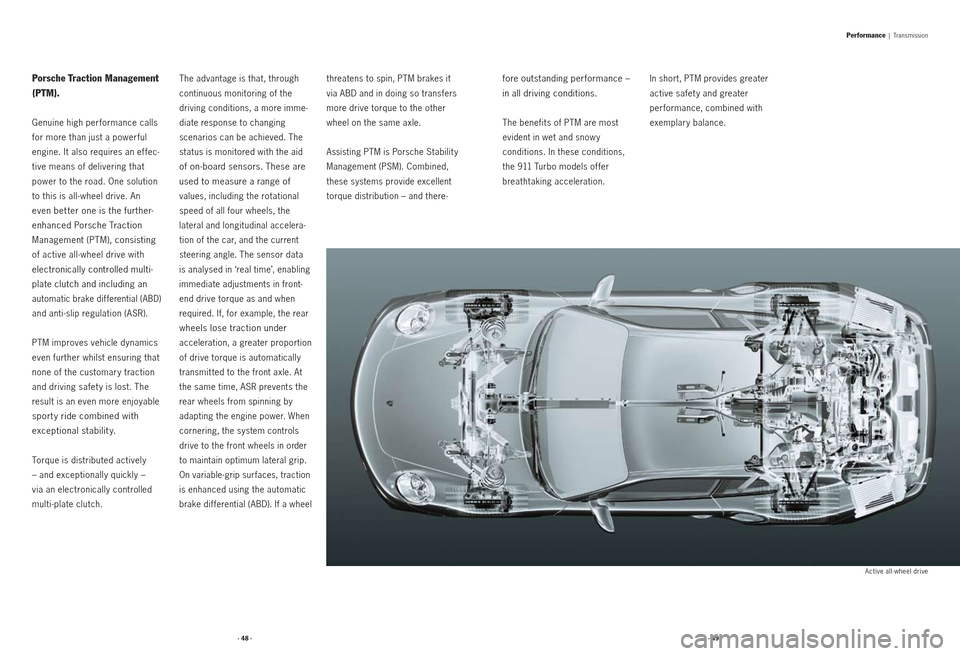
Porsche Traction Management
(P TM).
Genuine high per formance calls
for more than just a power ful
engine. It also requires an ef fec-
tive means of delivering that
power to the road. One solution
to this is all -wheel drive. An
even bet ter one is the further-
enhanced Porsche Traction
Management (PTM), consisting
of active all -wheel drive with
electronically controlled multi -
plate clutch and including an
automatic brake differential (ABD)
and anti -slip regulation (ASR).
PTM improves vehicle dynamics
even further whilst ensuring that
none of the customar y traction
and driving safet y is lost. The
result is an even more enjoyable
sport y ride combined with
exceptional stability.
Torque is distributed actively
– and exceptionally quickly –
via an electronically controlled
multi-plate clutch. The advantage is that, through
continuous monitoring of the
driving conditions, a more imme -
diate response to changing
scenarios can be achieved. The
status is monitored with the aid
of on-board sensors. These are
used to measure a range of
values, including the rotational
speed of all four wheels, the
lateral and longitudinal accelera -
tion of the car, and the current
steering angle. The sensor data
is analysed in ‘real time’, enabling
immediate adjustments in front-
end drive torque as and when
required. If, for example, the rear
wheels lose traction under
acceleration, a greater proportion
of drive torque is automatically
transmit ted to the front axle. At
the same time, ASR prevents the
rear wheels from spinning by
adapting the engine power. When
cornering, the system controls
drive to the front wheels in order
to maintain optimum lateral grip.
On variable-grip surfaces, traction
is enhanced using the automatic
brake dif ferential (ABD). If a wheel threatens to spin, PTM brakes it
via ABD and in doing so transfers
more drive torque to the other
wheel on the same axle.
Assisting PTM is Porsche Stabilit y
Management (PSM). Combined,
these systems provide excellent
torque distribution – and there
-
fore outstanding performance –
in all driving conditions.
The benefits of PTM are most
evident in wet and snow y
conditions. In these conditions,
the 911 Turbo models of fer
breathtaking acceleration. In short, PTM provides greater
active safet y and greater
performance, combined with
exemplary balance.
Performance | Transmission
Active all -wheel drive
· 48 ·· 49 ·
Page 29 of 59
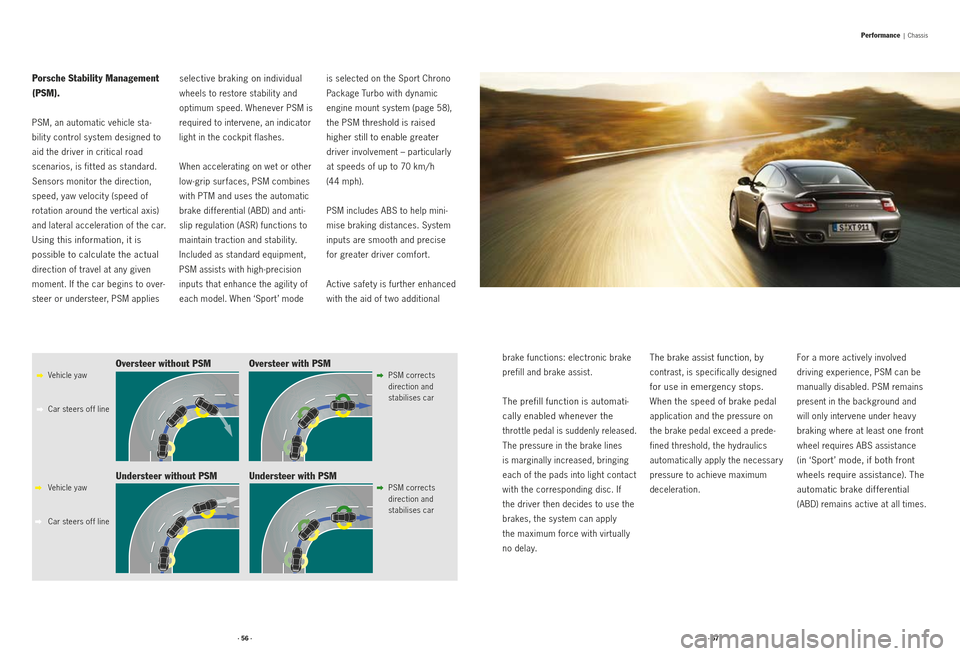
Porsche Stability Management
(PSM).
PSM, an automatic vehicle sta-
bilit y control system designed to
aid the driver in critical road
scenarios, is fit ted as standard.
Sensors monitor the direction,
speed, yaw velocit y (speed of
rotation around the vertical axis)
and lateral acceleration of the car.
Using this information, it is
possible to calculate the actual
direction of travel at any given
moment. If the car begins to over -
steer or understeer, PSM applies
selective braking on individual
wheels to restore stabilit y and
optimum speed. Whenever PSM is
required to intervene, an indicator
light in the cockpit flashes.
When accelerating on wet or other
low-grip surfaces, PSM combines
with PTM and uses the automatic
brake differential (ABD) and anti-
slip regulation (ASR) functions to
maintain traction and stabilit y.
Included as standard equipment,
PSM assists with high -precision
inputs that enhance the agilit y of
each model. When ‘Sport ’ mode is selected on the Sport Chrono
Package Turbo with dynamic
engine mount system (page 58),
the PSM threshold is raised
higher still to enable greater
driver involvement – particularly
at speeds of up to 70 km/ h
(44 mph).
PSM includes ABS to help mini -
mise braking distances. System
inputs are smooth and precise
for greater driver comfort.
Active safet y is further enhanced
with the aid of t wo additional
brake functions: electronic brake
prefill and brake assist.
The prefill function is automati-
cally enabled whenever the
throt tle pedal is suddenly released.
The pressure in the brake lines
is marginally increased, bringing
each of the pads into light contact
with the corresponding disc. If
the driver then decides to use the
brakes, the system can apply
the maximum force with virtually
no delay.
The brake assist function, by
contrast, is specifically designed
for use in emergency stops.
When the speed of brake pedal
application and the pressure on
the brake pedal exceed a prede -
fined threshold, the hydraulics
automatically apply the necessary
pressure to achieve maximum
deceleration. For a more actively involved
driving experience, PSM can be
manually disabled. PSM remains
present in the background and
will only intervene under heav y
braking where at least one front
wheel requires ABS assistance
(in ‘Sport ’ mode, if both front
wheels require assistance). The
automatic brake differential
(ABD) remains active at all times.
Vehicle yaw
Car steers of f line
Vehicle yaw
Car steers of f line PSM corrects
direction and
stabilises car
PSM corrects
direction and
stabilises carOversteer without PSM
Oversteer with PSM
Understeer with PSM
Understeer without PSM
Performance | Chassis
· 56 ·· 57 ·
Page 31 of 59
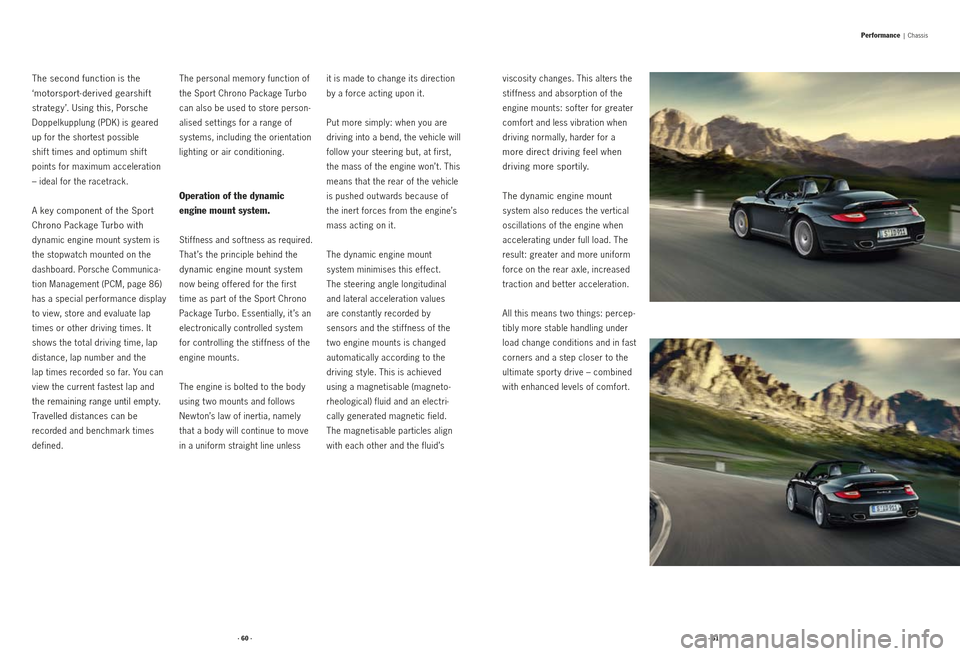
The second function is the
‘motorsport-derived gearshift
strategy’. Using this, Porsche
Doppel
kupplung (PDK) is geared
up for the shortest possible
shif t times and optimum shif t
points for maximum acceleration
– ideal for the racetrack.
A key component of the Sport
Chrono Package Turbo with
dynamic engine mount system is
the stopwatch mounted on the
dashboard. Porsche Communica -
tion Management (PCM, page 86)
has a special performance display
to view, store and evaluate lap
times or other driving times. It
shows the total driving time, lap
distance, lap number and the
lap times recorded so far. You can
view the current fastest lap and
the remaining range until empt y.
Travelled distances can be
recorded and benchmark times
defined. The personal memory function of
the Sport Chrono Package Turbo
can also be used to store person
-
alised set tings for a range of
systems, including the orientation
lighting or air conditioning.
Operation of the dynamic
engine mount system.
Stiffness and softness as required.
That ’s the principle behind the
dynamic engine mount system
now being of fered for the first
time as part of the Sport Chrono
Package Turbo. Essentially, it ’s an
electronically controlled system
for controlling the stif fness of the
engine mounts.
The engine is bolted to the body
using t wo mounts and follows
New ton’s law of inertia, namely
that a body will continue to move
in a uniform straight line unless it is made to change its direction
by a force acting upon it.
Put more simply: when you are
driving into a bend, the vehicle will
follow your steering but, at first,
the mass of the engine won’t. This
means that the rear of the vehicle
is pushed out wards because of
the inert forces from the engine’s
mass acting on it.
The dynamic engine mount
system minimises this effect.
The steering angle longitudinal
and lateral acceleration values
are constantly recorded by
sensors and the stif fness of the
t wo engine mounts is changed
automatically according to the
driving st yle. This is achieved
using a magnetisable (magneto -
rheological) fluid and an electri -
cally generated magnetic field.
The magnetisable particles align
with each other and the fluid’s viscosit y changes. This alters the
stif fness and absorption of the
engine mounts: sof ter for greater
comfort and less vibration when
driving normally, harder for a
more direct driving feel when
driving more sportily.
The dynamic engine mount
system also reduces the vertical
oscillations of the engine when
accelerating under full load. The
result: greater and more uniform
force on the rear axle, increased
traction and bet ter acceleration.
All this means t wo things: percep -
tibly more stable handling under
load change conditions and in fast
corners and a step closer to the
ultimate sport y drive – combined
with enhanced levels of comfort.
Performance | Chassis
· 60 ·· 61 ·
Page 37 of 59
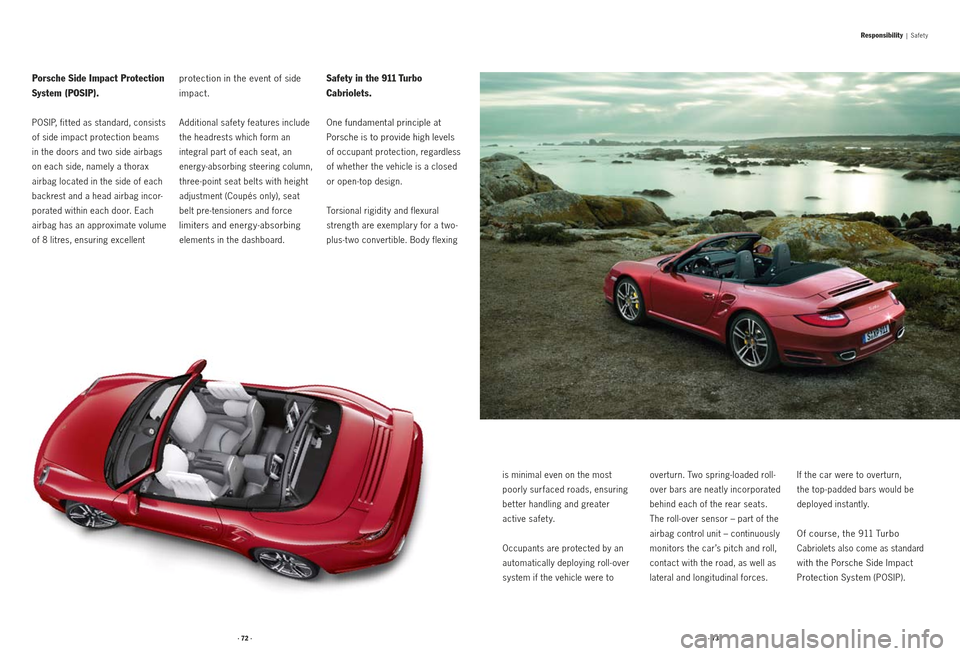
Porsche Side Impact Protection
System (POSIP).
POSIP, fit ted as standard, consists
of side impact protection beams
in the doors and t wo side airbags
on each side, namely a thorax
airbag located in the side of each
backrest and a head airbag incor-
porated within each door. Each
airbag has an approximate volume
of 8 litres, ensuring excellent
protection in the event of side
impact.
Additional safet y features include
the headrests which form an
integral part of each seat, an
energy-absorbing steering column,
three-point seat belts with height
adjustment (Coupés only), seat
belt pre-tensioners and force
limiters and energy-absorbing
elements in the dashboard.
Safety in the 911 Turbo
Cabriolets.
One fundamental principle at
Porsche is to provide high levels
of occupant protection, regardless
of whether the vehicle is a closed
or open-top design.
Torsional rigidit y and flexural
strength are exemplary for a t wo -
plus-t wo convertible. Body flexing
is minimal even on the most
poorly surfaced roads, ensuring
bet ter handling and greater
active safety.
Occupants are protected by an
automatically deploying roll- over
system if the vehicle were to overturn. Two spring-loaded roll-
over bars are neatly incorporated
behind each of the rear seats.
The roll- over sensor – part of the
airbag control unit – continuously
monitors the car’s pitch and roll,
contact with the road, as well as
lateral and longitudinal forces.
If the car were to overturn,
the top -padded bars would be
deployed instantly.
Of course, the 911 Turbo
Cabriolets also come as standard
with the Porsche Side Impact
Protection System (POSIP).
Responsibility | Safet y
· 72 ·· 73 ·
Page 43 of 59
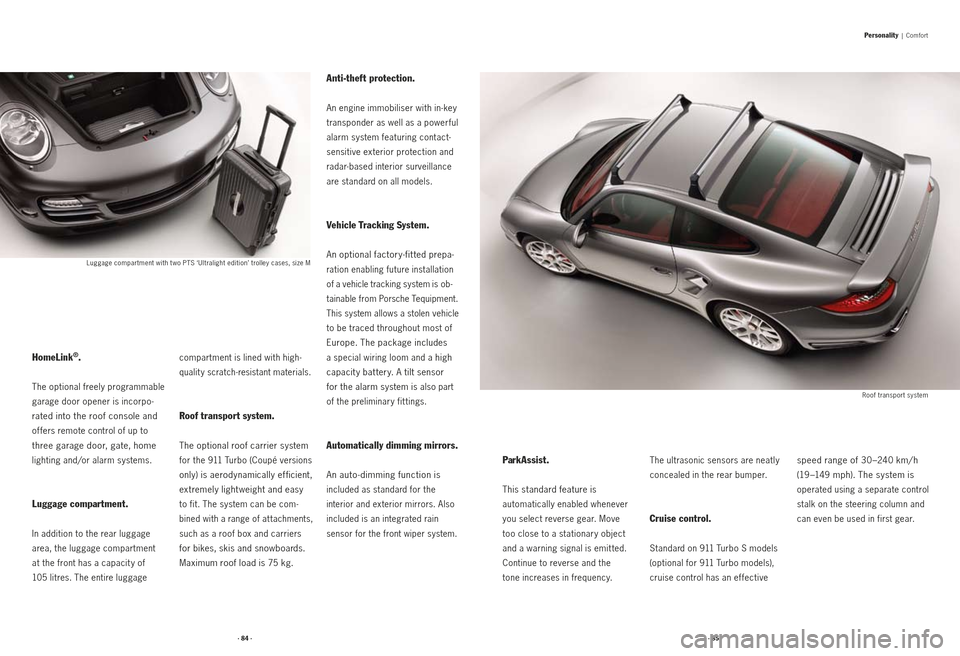
HomeLink®.
The optional freely programmable
garage door opener is incorpo-
rated into the roof console and
of fers remote control of up to
three garage door, gate, home
lighting and/or alarm systems.
Luggage compartment.
In addition to the rear luggage
area, the luggage compartment
at the front has a capacit y of
105 litres. The entire luggage compartment is lined with high-
qualit y scratch - resistant materials.
Roof transport system.
The optional roof carrier system
for the 911 Turbo (Coupé versions
only) is aerodynamically efficient,
extremely light weight and easy
to fit. The system can be com -
bined with a range of at tachments,
such as a roof box and carriers
for bikes, skis and snowboards.
Maximum roof load is 75 kg.
Anti-theft protection.
An engine immobiliser with in -key
transponder as well as a powerful
alarm system featuring contact-
sensitive exterior protection and
radar-based interior surveillance
are standard on all models.
Vehicle Tracking System.
An optional factory-fit ted prepa -
ration enabling future installation
of a vehicle tracking system is ob -
tainable from Porsche Tequipment.
This system allows a stolen
vehicle
to be traced throughout most of
Europe. The package includes
a special wiring loom and a high
capacit y bat tery. A tilt sensor
for the alarm system is
also part
of the preliminary fit tings.
Automatically dimming mirrors.
An auto -dimming function is
included as standard for the
interior and exterior mirrors. Also
included is an integrated rain
sensor for the front wiper system.
ParkAssist.
This standard feature is
automatically enabled whenever
you select reverse gear. Move
too close to a stationary object
and a warning signal is emit ted.
Continue to reverse and the
tone increases in frequency. The ultrasonic sensors are neatly
concealed in the rear bumper.
Cruise control.
Standard on 911 Turbo S models
(optional for 911 Turbo models),
cruise control has an ef fective
speed range of 30 –240 km/ h
(19–149 mph). The system is
operated using a separate control
stalk on the steering column and
can even be used in first gear.
Luggage compartment with t wo PTS ‘Ultralight edition’ trolley cases, size M
Roof transport system
Personality | Comfort
· 84 ·· 85 ·